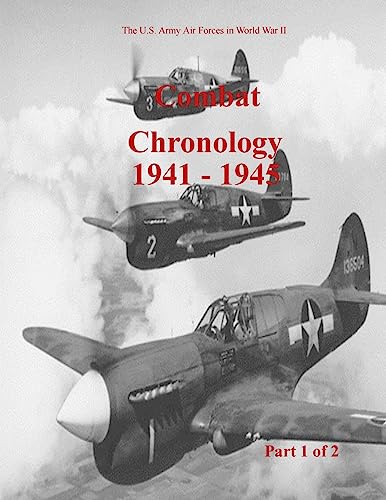Verwandte Artikel zu Combat Chronology 1941-1945 (Part 1 of 2) (U.S. Army...

Zu dieser ISBN ist aktuell kein Angebot verfügbar.
Alle Exemplare der Ausgabe mit dieser ISBN anzeigen:
Reseña del editor:
Part 1 of 2 The chronology is concerned primarily with operations of the US Army Air Forces and its combat units between December 7, 1941 and September 15, 1945. It is designed as a companion reference to the seven-volume history of The Army Air Forces in World War II, edited by Wesley Frank Craven and James Lea Cate. The research was a cooperative endeavor carried out in the United States Air Force historical archives by the Research Branch of the Albert F. Simpson Historical Research Center. Such an effort has demanded certain changes in established historical methodology, as well as some arbitrary rules for presentation of the results. After International and US events, entries are arranged geographically. They begin with events at Army Air Forces Headquarters in Washington then proceed eastward around the world, using the location of the headquarters of the numbered air forces as the basis for placement. For this reason, entries concerning the Ninth Air Force while operating in the Middle East follow Twelfth Air Force. When that headquarters moves to England in October 1943, the entries are shifted to follow Eighth Air Force. The entries end with those numbered air forces which remained in the Zone of the Interior, as well as units originally activated in the ZI, then designated for later movement overseas, such as Ninth and Tenth Air Forces. The ZI entries do not include Eighth and Twentieth Air Forces, which were established in the ZI with the original intent of placing them in those geographical locations with which they became historically identified. For these two units, original actions are shown either under AAF or in their intended geographic area of location. All times and dates used are those of the area under discussion. The entry "1/2 Jun" indicates that an event occurred during the night between the two given dates, while "1-2 Jun" indicates an action over a period of time. In dealing with people, again arbitrary decisions were implemented. For military men below the general officer or equivalent level, full grade and name were used. For general officers and those of equal grade in other US and foreign services, the complete rank (both that at the time first mentioned and the highest rank held prior to the end of the war) and name will be found in the index. Only an abbreviated rank (e.g., Gen or Adm) and last name are used in the text. The exception is where two general officers had the same last name; in such cases, the first name is also included. Similarly for civilian leaders, only the last name is used; full name and title are given in the index. Location of all towns, islands, etc., is also made in the index. In all cases, attempts were made to cite place names in use by the native population at the time of or immediately before the war. No names imposed by a conqueror are used. For example Pylos Bay, not Navarino Bay, is used. Further, as appropriate, native geographic terms are used: Shima for island in. Japanese island groups, See for lake in Germany. However, two exceptions were made. In cases in which the place became infamous because of the actions of the conquering power, that name is preferred-for example Auschwitz would be used rather than the Polish name of Oswiecim. Also, in larger international cities, such as Roma, Koln and Wien, the anglicized name is used. Where a village or hamlet was difficult to locate or where there were several such places with the same name in a general area, the coordinates are given in the index. In some cases, with no extant navigational aids of the attacking force, the best possible guess was made based upon all available evidence. In other instances, such as the bridge at Hay-ti-attacked so often by Tenth Air Force-- a logical guess could not be made. In these cases, a question mark is placed in brackets after the index entry. Accent marks, such as umlauts, were omitted.
„Über diesen Titel“ kann sich auf eine andere Ausgabe dieses Titels beziehen.
- VerlagCreateSpace Independent Publishing Platform
- Erscheinungsdatum2015
- ISBN 10 1507814461
- ISBN 13 9781507814468
- EinbandTapa blanda
- Anzahl der Seiten278
(Keine Angebote verfügbar)
Buch Finden: Kaufgesuch aufgebenSie kennen Autor und Titel des Buches und finden es trotzdem nicht auf ZVAB? Dann geben Sie einen Suchauftrag auf und wir informieren Sie automatisch, sobald das Buch verfügbar ist!
Kaufgesuch aufgeben